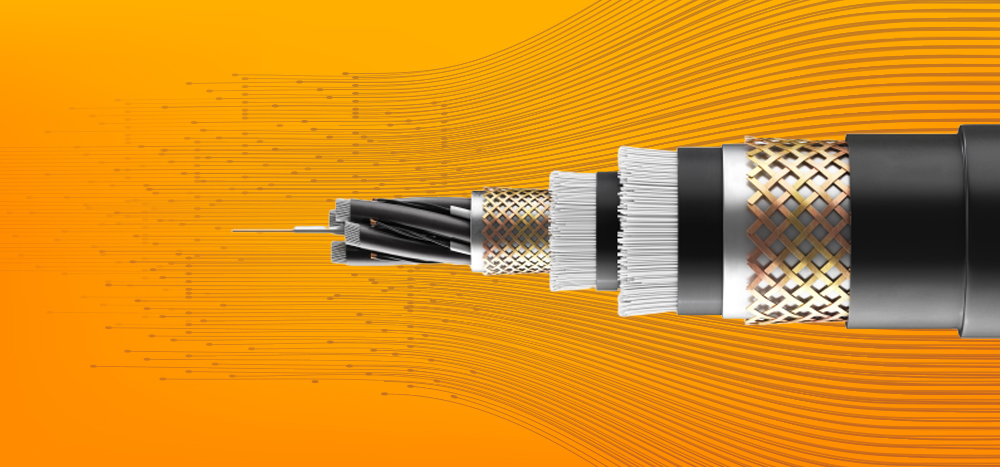
The need to stay always connected, for individuals as well as for enterprises, has set the demand rolling for high internet speeds with high quality and consistency. Further, innovations in the telecom sector have increased the deployment of broadband-based network architectures. This all has given a huge growth opportunity for the fiber optic cable (OFC) industry.
Contents
- 1 The Science Behind Fibre Optic Cables
- 2 What is optical fiber cable?
- 3 What is optical fiber cable used for?
- 4 What are the different types of fibre optic cables?
- 5 Difference between multimode and singlemode Fibre optic cable
- 6 How are fiber optic cables deployed?
- 7 Optical Fibre Cable Manufacturing in India
- 8 STL’s cutting-edge end-to-end solutions
- 9 FAQs
- 9.1 1. Who invented fibre optics?
- 9.2 2. What are the two types of fibre optic cables?
- 9.3 3. What equipment is needed for fibre optic internet?
- 9.4 4. What is used for the fabrication of optical fibres that are used for communication?
- 9.5 5. Why silica is used for the fabrication of the optical fibers?
- 9.6 6. What is the principle of fibre optical communication?
- 9.7 7. What is the bandwidth of optical fiber?
- 9.8 8. List a few advantages of optical fiber communication.
The Science Behind Fibre Optic Cables
Optical Fibre is hair-thin material made of glass. Generally, optical fiber has a diameter of 125 micrometers (μm), which is actually the diameter of the cladding, or outer reflecting layer. The core, or inner transmitting cylinder, may have a much smaller diameter (sometimes 10 μm). Through the process of total internal reflection, light rays are reflected into the fibers within the core. This can happen for great distances with little attenuation or reduction in density. The degree of attenuation varies according to the wavelength, with little attenuation in intensity.
What is optical fiber cable?
A fiber-optic cable is composed of very thin strands of glass or plastic known as optical fibers; one cable can have as few as two strands or as many as several hundreds of them. These optical fiber cables carry information in the form of data between two places using optical or light-based technology. Once the light beams travel down the optical fiber cable (OFC), they would emerge at the other end. A photoelectric cell will be required to turn the pulses of light back into electrical information the computer can understand.
While traveling down fiber optic cable, light bounces repeatedly off the walls. The beam of light does not leak out of the edges because it hits the glass at really shallow angles. And then it reflects back again as if the glass were really a mirror. This is called total internal reflection. The other factor that keeps it in the pipe is the cable structure.
Fiber cable offers many advantages, the prime ones being higher bandwidth and reach. Optical fibre cables (OFC) are now preferred over old copper telecom cables as they provide high-speed broadband services. Optical fibre loses 3% of the signal over 100 meters of distance, while copper wires lose 94%. Additionally, optical fibres are more long-lasting as compared to copper wires, which are much more fragile. Copper wire can be tapped very easily, while optical fibres do not radiate signals that can be tapped. Optical fibre offers much lower latency (the amount of time required to perform data transmission) compared to copper wires.
What is optical fiber cable used for?
The Indian optical fiber cable market is gaining traction. The growth is driven by continued investments being made by the Indian government in developing OFC network infrastructure, in various projects. The Indian market for optical fibre cable (OFC) is projected to grow at a CAGR of 17% through 2023. There has been increased adoption of Fiber-to-the-Home (FTTH) connectivity owing to government initiatives such as Digital India, Smart Cities, or Bharatnet. Moreover, the growing number of data centers in India will fuel this growth further.
The telecom industry is among the primary applications of optical fiber communication. The increasing need for 24×7 high-speed connectivity and an increase in data traffic due to services such as voice, messaging, emails, downloads, and video streaming is made possible only with optical fibre communication.
Indian OFC manufacturers have been making great efforts to meet domestic demand for optic fibre cable. For this, they also need support to ensure sustainable development to the overall economy. In several developed countries, initiatives like tax incentives, substantial project subsidies, and financial support for R&D have assisted domestic players to proliferate. The Indian manufacturers have the capability and capacity, and they also need a similar kind of support from the government.
STL Tech is one of the most trusted end-to-end optical fibre manufacturers in India and the only company in the world with a fully integrated silicon-to-software pipeline. We specialize in everything from manufacturing optical fiber cables of various types and for various applications, to designing and installing integrated hyper-scale fiber optic networks. STL’s innovative optical fibre products are utilized in a plethora of large-scale applications such as long-haul, metropolitan, FTTx, CATV, smart city, intelligent traffic networks, access, defence-security, and premise. We also specialize in various optical fiber cable configurations such as ribbon, loose tube, and tight buffered for all types of aerial and underground deployments.
Since 2019, STL has invested over INR 1500 crores in expanding its optical fibre manufacturing capacity from 30,000 fiber km to 50,000 fiber km. Our global optical fibre working network currently stands at 33 million fibre km, catering to India and other international geographies like the UK and the US. STL’s worldwide footprint encapsualtes next-gen optical preform, fibre, cable, and interconnect subsystem manufacturing facilities in countries like India, China, Brazil, and Italy.
STL partners with telecom operators, government organisations, internet service providers, infrastructure companies, public utility providers, and more in order to deliver and install high-end, high-performance optical fibre networks of the future. In India, STL has partnered with various state governments to maintain the country’s nationwide optic fiber network program – BharatNet. Moreover, STL’s Centre of Excellence offers state-of-the-art core research and development in fibre technology and has yielded over 216 patents in the industry.
What are the different types of fibre optic cables?
The optical fibre cable is classified based on three factors – the refractive index, the materials used, and the mode of propagation of light.
The basis of the refractive index OFC is of two types:
- Step Index Fibers: It comprises a core enclosed by the cladding, which has a single uniform index of refraction.
- Graded Index Fibers: The refractive index of the optical fiber decreases as the radial distance from the fiber axis increases.
Based on materials, OFC is of two types:
- Plastic Optical Fibers: The poly(methyl methacrylate) is used as a core material for the transmission of light.
- Glass Fibers: This fiber cable consists of extremely fine glass fibers.
Based on the mode of propagation of light, OFC is divided into:
- Single-Mode Fibers: Used for long-distance transmission of signals.
- Multimode Fibers: Used for short-distance transmission of signals.
Difference between multimode and singlemode Fibre optic cable
Based on product type, the market can be divided into single-mode fiber and multi-mode fiber. Single mode optical fibre allows one type of light mode to be propagated at a time. However, multi-mode fiber cable can propagate multiple modes. Multi-mode optical fiber can be used for short-distance runs, while single mode fiber cable can be used for long-distance applications. Hence, the mode fiber segment is expected to grow much faster during the forecast period owing to their long-distance applications and low installation costs as compared to multi-mode fiber.
Single mode fiber optic cable‘s core diameter (9 µm) is much smaller than multimode fiber (50 µm and 62.5 µm). Its typical core diameter is 9 µm. This enables the multimode fiber to have a higher “light-gathering” ability and simplify connections. The cladding diameter of single mode and multimode fiber is 125 µm.
How are fiber optic cables deployed?
Today’s digital life is expanding and requiring high-speed connectivity in more areas of society and business. There are numerous types of fibre optic deployments:
Fiber to the Home (FTTH) or Fiber to the Premise (FTTP): The fiber cable ends where the living space begins. For example, a box on a home’s exterior wall. This is a full fibre link.
Fiber to the Building (FTTB): The optical fibre terminates at the building’s perimeter. For example, consider the box in an apartment building’s basement.
Fiber to the Node (FTTN): In this case, fiber optic cable terminates at the street cabinet, which could be miles away from the customer’s location. Coax is used for the last mile connection.
Fiber to the Curb or Cabinet (FTTC): This is similar to FTTN, except that the fiber cable is terminated closer to the premises, less than a mile away. Copper wire is used for the last mile connection.
Fiber to the Antenna (FTTA): When an antenna is fed with optical fibre, this occurs (also known as fibre backhaul). To meet the high 5G bandwidth requirements, 5G fiber optics like an FTTA architecture is required.
Fiber to the Desk (FTTD): This is a common commercial fiber optic cable deployment. Fiber, like copper cable, is distributed from a telecommunication room to the equipment outlets and terminated at a faceplate.
Optical Fibre Cable Manufacturing in India
Sterlite Technologies Limited is one of the industry’s leading optical fibre cable manufacturers in India, along with top digital network integrators, offering All-in 5G solutions. STL’s customized optical fibre cable solutions are designed to support high-bandwidth applications in data centres, global internet companies, ISPs and telcos, and citizen network services. STL provides a diverse range of OFC cables, including micro duct, aerial, underground, IO ribbon, indoor, and special application cable.
STL’s most popular fiber optic cable solutions include:
- World’s Most Slim 432F Next Gen Micro Cable
Optical fibre with improved bend radius reduces macro bend signal losses. It’s ideal for use in ACCESS/FTTH networks.
- WorkSafe Cable: Aerial Lite Drop Cable
Micro Module Buffer tubes is combined with a break load range of 1350N-1800N
- Yogalite Cable: Most versatile Family of Cables
Yogalite cables reduce installation time by 30%. These are based on STL’s patented bend insensitive fibre technology and Microlite.
- FlashFWD Cable: 5G Ready Solution
FlashFWD Ribbon fiber cable for dense networks is available in two configurations:
- 864F ribbon cable with six tubes
- 1152F ribbon cable with eight tubes
STL has invested up to Rs 1,500 crore since 2019, increasing its optic fibre manufacturing capacity from 30 million to 50 million km, and currently has an order book worth Rs 11,000 crore. Sterlite Technologies also intends to invest Rs 200 crore to increase optic fibre production by 25% in its US and UK facilities.
STL’s cutting-edge end-to-end solutions
STL’s fully 5G-ready digital network solutions assist telcos, cloud companies, citizen networks, and large enterprises in providing enhanced customer experiences. Our optical fibre communication solutions include:
- Opticonn: Optical Connectivity Solutions
- Lead 360: Fibre Deployment Solutions
- FTTx Mantra: FTTx Access Network Solutions
- Netmode: Network Modernization Solutions
The importance of fiber optic networks in 5G
Before 5G turns out to be a reality, a 5G fiber optic network infrastructure must be used to support devices and megabits of data that will be transmitted over the network.
5G has a huge application of optical fiber. To take advantage of everything 5G has to offer, a denser, fiber-rich network infrastructure will be required to deliver the key performance indicators: longer battery life, lower latency, ultra-high reliability, higher data rates, and increased device connectivity. This is possible only with various optical fibre.
FAQs
1. Who invented fibre optics?
Charles Kuen Kao discovered certain physical properties of glass in the 1960s, which laid the groundwork for high-speed data communication in the Information Age
2. What are the two types of fibre optic cables?
There are two types of fibre optic cables – multimode and single-mode. Multimode optical fibre or OFC is capable of carrying multiple light rays (modes) at the same time as it has varying optical properties at the core. Single-mode fibre has a much smaller core size (9 microns). It has a single light path and can travel much longer distances of up to 100km.
3. What equipment is needed for fibre optic internet?
Service providers require a fiber-ready router (often called a “residential gateway” by internet providers) in order to accommodate fiber-optic speeds.
4. What is used for the fabrication of optical fibres that are used for communication?
Optical
fibers are fabricated in a multi-step process:
First,
there is preform fabrication, followed by optical
fibre
drawing, fiber
coating, and spooling. A preform is a giant-sized version of the
final fiber product. It has a central core and cladding refractive
indices that are equal to those of the desired product.
5. Why silica is used for the fabrication of the optical fibers?
Because silica has a wide wavelength range with good optical transparency. It can be drawn into fibres at reasonably high temperatures and has a conveniently broad glass transition (a relatively shallow viscosity curve).
6. What is the principle of fibre optical communication?
Fiber optical communication works on the principle of total internal reflection by which light signals can be transmitted from one location to another with zero loss of energy.
7. What is the bandwidth of optical fiber?
Optical fibre has high bandwidth due to the speed at which data can be transmitted and the range of frequencies over which data can travel without any attenuation.
8. List a few advantages of optical fiber communication.
- Fiber optic cable has a much higher bandwidth as compared to copper cables.
- Optical fibre can transfer a large amount of data as compared to other metal cables.
- OFC cable iseconomical and cost-efficient with less power consumption.
- Durable and flexible with less signal degradation.















1 Comment
Manish
April 19, 2021Really good coverage of Optical Fiber topics